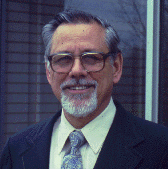 Russel
Young Russel
Young
Russell D. Young obtained his
B.S. degree in physics from the Rensselaer Polytechnic Institute in 1953
and his Ph.D. degree in physics from Pennsylvania State University in
1959. He remained at Penn State in the laboratory of Professor Erwin Mueller
for his postdoctoral research, which was marked by several outstanding
achievements. Among these were the development of a high resolution field
emission energy analyzer and the first measurement of the total energy
distribution of field emitted electrons, as well as contributions to the
development of the low temperature field ion microscope. He came to the
National Bureau of Standards in 1961.
As long as in 1966 Russell Young
has stated idea about an opportunity of surface topografing with usage
of current between surface and sharp metallic tip. In 1971 he have published
paper about device colled Topografiner,
which contained all major assemblies of Scanning Probe Microscope. His development of the Topografiner
was an outgrowth of his continued study of surfaces at NBS. After the
termination of this project in 1971, he remained at NBS in both a technical
and an administrative role until his retirement in 1981. Since then he
has actively pursued his interests as an inventor, as a private consultant
to industry and government (including NIST), and as a grandfather and
a sailor. Dr. Young's achievements have been recognized in several
awards. In 1974, he was the first recipient of the Edward U. Condon Award,
conferred by NBS in recognition of outstanding scientific writing. He
received the U.S. Department of Commerce Silver Medal in 1979, a Presidential
Citation in 1986, and the Scientific Achievement Award of the Washington
Academy of Sciences in 1987. In 1992, the American Vacuum Society recognized
his invention of the Topografiner
by presenting him with the Gaede-Langmuir Award.
Description
of Topografiner was published
in papers ( Phys. Rev. Lett. V. 27, N 14, 1971, P. 922-924.) ( Rev. Sc.
Instr. V. 43, N 7,1972, P. 999-1011.).
|
|

